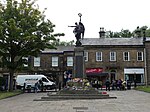Glossop Hall

Glossop Hall was the last residential building on the site of Royle Hall in Glossop, Derbyshire. It was located south of Old Glossop at the heart of Glossop before the centre of the town shifted to Norfolk Square in the nineteenth century. It was a residence used by members of the Howard family. Work started on the penultimate building around 1730 and it was used as a hunting lodge by Phillipa Howard, daughter of Henry Howard, 6th Duke of Norfolk, and her husband. The building as shown was only used for part of the year. Rebuilt around 1870 by Lord Howard of Glossop and sold to the council in 1924, it became Kingsmoor School and was eventually demolished around 1950. The house lies beneath a small housing estate with road names such as Old Hall Close and Park Close. The original terraced gardens now form Manor Park.
Excerpt from the Wikipedia article Glossop Hall (License: CC BY-SA 3.0, Authors, Images).Glossop Hall
Kingsmoor Road, High Peak Old Glossop
Geographical coordinates (GPS) Address Nearby Places Show on map
Geographical coordinates (GPS)
| Latitude | Longitude |
|---|---|
| N 53.4485 ° | E -1.9443 ° |
Address
Kingsmoor Road
Kingsmoor Road
SK13 7RG High Peak, Old Glossop
England, United Kingdom
Open on Google Maps










